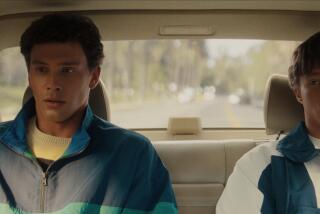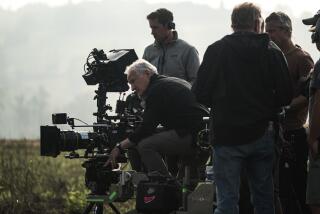‘MANHUNTER’ RESOUNDS WITH THE MARK OF MANN
What a ferocious movie “Manhunter” is. In the hands of director Michael Mann, it’s a dark locomotive of a film, roaring straight ahead, dragging its audience with it.
A psychological detective story, its most lingering characters are its twin sadistic killers. The more diabolically brilliant one is behind bars in a hospital for the criminally insane; the second is still free, killing entire young families in apparently random fashion. The link between the two is an FBI forensics expert with a knack of putting himself into a killer’s skin in an attempt to predict his behavior. He has caught the first, at nearly the cost of his own life, and is hard on the trail of the second.
You don’t need to be a forensics expert to link Mann with “Manhunter”--it has his fingerprints all over it: the searing sound and visuals that made him, after “Thief,” a hard-edge, interesting director to watch. The style deepened with “The Keep,” which moved from “Thief’s” Chicago to a Balkan forest fortress (and was either kitsch or profound, depending on your point of view and/or tendency to giggle in movies), and it extended to television, with the Mann-produced “Miami Vice.” (When you look at the tidal wave of pastels we’re struggling out of now, you realize that, visually, Mann has a lot to answer for.)
Whether the setting is a Chicago used-car lot, a Ruritanian forest fastness or a bedroom at the edge of the Florida coast, each of Mann’s films have a shimmeringly beautiful surface and a harsh center; their photography, editing and music are synchronized to bring us to the edges of our seats and keep us there, and the films are increasingly laconic and macho .
Suddenly, with “Manhunter,” there are hints that Mann is at--and sometimes over--the edge of self-parody: that a smart young director with style to burn should perhaps burn the style.
Mann generally writes or adapts his own scripts, and the changes he’s made in adapting Thomas Harris’ breathtaking popular novel “Red Dragon” into “Manhunter” are fascinating. First of all, it’s a heroic job. With a novelist’s narrative freedom, Harris was able to take us back to hunted killer Francis Dolarhyde’s childhood as a abused, abandoned child with a severe cleft palate. (The film changes the spelling of both the villain’s names, Dolarhyde and Lector, to Dollarhyde and Lektor, to make them--what? Impossible to mispronounce? More like a Saturday matinee villain: Dr. Lektor?) Mann and actor Tom Noonan are able to convey the weight of a tortured childhood without such flashbacks.
Mann has also brought Harris’ graphic and harrowingly explicit book to the screen with a real minimum of bloodletting until a crashing shoot-out finale, changed from the novel’s last horrific surprise. As adapter, Mann has cannily moved the menace from in front of our eyes to around behind them, to our minds, an even more febrile environment. He’s made his film in huge, clean, isolated images, like a soulless Antonioni. It’s part of a deliberate design, Mann has said, to distance the audience; to make the surface as beautiful as he knows how, to let the movie work in the imagination.
Whether it frees our minds or not is the question. Some minds may still trip over Dr. Lektor’s high-tech environment in which everything, floor to ceiling, including the prisoner’s clothes, and even his pallor, is milk-white. Taunted by Lektor that they share the same mind, the detective, Will Graham, bursts out of the place and down its sloping white ramps--a veritable Guggenheim for the criminally insane. (Actually, it’s Atlanta’s High Museum of Art.)
The FBI seems to work in similarly improbable digs, in stylized, (mostly) uncluttered handsomeness. One sequence poses the actors against floor-to-ceiling white filing cabinets with white Conran hardware. I’m not so sure all this visual chic does clear the mind; it also seems to clear away common sense.
In taking off all the rough edges so his film won’t be slowed in the slipstream, Mann may also have planed away too many burrs of character. You’d be surprised at the changes in the detective’s wife, Molly, a whale of a character in the book: a tall young widow with a young son, a woman who loves Doc Watson’s guitar and teaches her second husband clog dancing in the backyard.
Molly is the book’s ultimate tough guy, a staunch, salty dame of real substance who gives her man grief when she thinks he’s going wrong. The film’s Molly is lean and loving, all right, but you suspect that her theme music is Tammy Wynette’s “Stand By Your Man,” not Doc Watson. Standing by men, and Mann, is all poor Molly is left to do. As for clog dancing, anything so quirky is unthinkable.
Ultimately, that’s the element that Mann’s movie misses most of all: plain old messy humanity. The book’s “Kissin’ Don’t Last, Cookin’ Do” sampler on one of the victim’s kitchen walls is gone with the movie’s streamlining chic. Also erased is any trace of the most crucial element of survival, humor: bitter humor, ironic humor, even the banter between men who’ve worked together for years that permeated the book and made it feel honest. High tech, high gloss may make Mann the quintessential director for the ‘80s, but a sense of humor--of the outlandishness of individuality--is crucial. Hitchcock certainly knew its power; Mann still knew it in “Thief,” and intermittently in “Miami Vice.” In interviews Mann himself is full of a sardonic Chicago jokiness. He needs it to leaven the dead-earnestness of “Manhunter.”
Mann’s strengths are still with him. He has a great gift for casting and with actors: He launched Robert Prosky and refound Don Johnson, used the fascinating Alberta Watson in “The Keep” and the extraordinary Brian Cox here as Dr. Lektor, a characterization that compacts and telegraphs brilliance and evil.
Mann has equally refined taste in his behind-the-camera artists, his (constant) editor, his (changing) cameramen. He can build uncliched sequences of powerful eroticism like “Manhunter’s” amazing tiger scene. He also defies the hoary movie view of the blind as unsexed and unpowerful in “Manhunter.” What we can hope is that his high-tech period will be just that; a marker, not a roadblock to a provocative career.
More to Read
Only good movies
Get the Indie Focus newsletter, Mark Olsen's weekly guide to the world of cinema.
You may occasionally receive promotional content from the Los Angeles Times.










